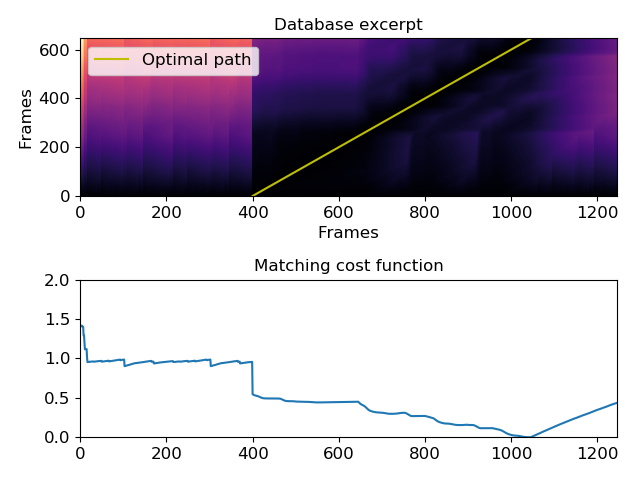librosa.core.dtw¶
-
librosa.core.dtw(X=None, Y=None, C=None, metric=’euclidean’, step_sizes_sigma=None, weights_add=None, weights_mul=None, subseq=False, backtrack=True, global_constraints=False, band_rad=0.25)[source]¶ Dynamic time warping (DTW).
This function performs a DTW and path backtracking on two sequences. We follow the nomenclature and algorithmic approach as described in [1].
[1] Meinard Mueller Fundamentals of Music Processing — Audio, Analysis, Algorithms, Applications Springer Verlag, ISBN: 978-3-319-21944-8, 2015. Parameters: - X : np.ndarray [shape=(K, N)]
audio feature matrix (e.g., chroma features)
- Y : np.ndarray [shape=(K, M)]
audio feature matrix (e.g., chroma features)
- C : np.ndarray [shape=(N, M)]
Precomputed distance matrix. If supplied, X and Y must not be supplied and
metricwill be ignored.- metric : str
Identifier for the cost-function as documented in scipy.spatial.cdist()
- step_sizes_sigma : np.ndarray [shape=[n, 2]]
Specifies allowed step sizes as used by the dtw.
- weights_add : np.ndarray [shape=[n, ]]
Additive weights to penalize certain step sizes.
- weights_mul : np.ndarray [shape=[n, ]]
Multiplicative weights to penalize certain step sizes.
- subseq : binary
Enable subsequence DTW, e.g., for retrieval tasks.
- backtrack : binary
Enable backtracking in accumulated cost matrix.
- global_constraints : binary
Applies global constraints to the cost matrix
C(Sakoe-Chiba band).- band_rad : float
The Sakoe-Chiba band radius (1/2 of the width) will be
int(radius*min(C.shape)).
Returns: - D : np.ndarray [shape=(N,M)]
accumulated cost matrix. D[N,M] is the total alignment cost. When doing subsequence DTW, D[N,:] indicates a matching function.
- wp : np.ndarray [shape=(N,2)]
Warping path with index pairs. Each row of the array contains an index pair n,m). Only returned when
backtrackis True.
Raises: - ParameterError
If you are doing diagonal matching and Y is shorter than X or if an incompatible combination of X, Y, and C are supplied. If your input dimensions are incompatible.
Examples
>>> import numpy as np >>> import matplotlib.pyplot as plt >>> y, sr = librosa.load(librosa.util.example_audio_file(), offset=10, duration=15) >>> X = librosa.feature.chroma_cens(y=y, sr=sr) >>> noise = np.random.rand(X.shape[0], 200) >>> Y = np.concatenate((noise, noise, X, noise), axis=1) >>> D, wp = librosa.dtw(X, Y, subseq=True) >>> plt.subplot(2, 1, 1) >>> librosa.display.specshow(D, x_axis='frames', y_axis='frames') >>> plt.title('Database excerpt') >>> plt.plot(wp[:, 1], wp[:, 0], label='Optimal path', color='y') >>> plt.legend() >>> plt.subplot(2, 1, 2) >>> plt.plot(D[-1, :] / wp.shape[0]) >>> plt.xlim([0, Y.shape[1]]) >>> plt.ylim([0, 2]) >>> plt.title('Matching cost function') >>> plt.tight_layout()
